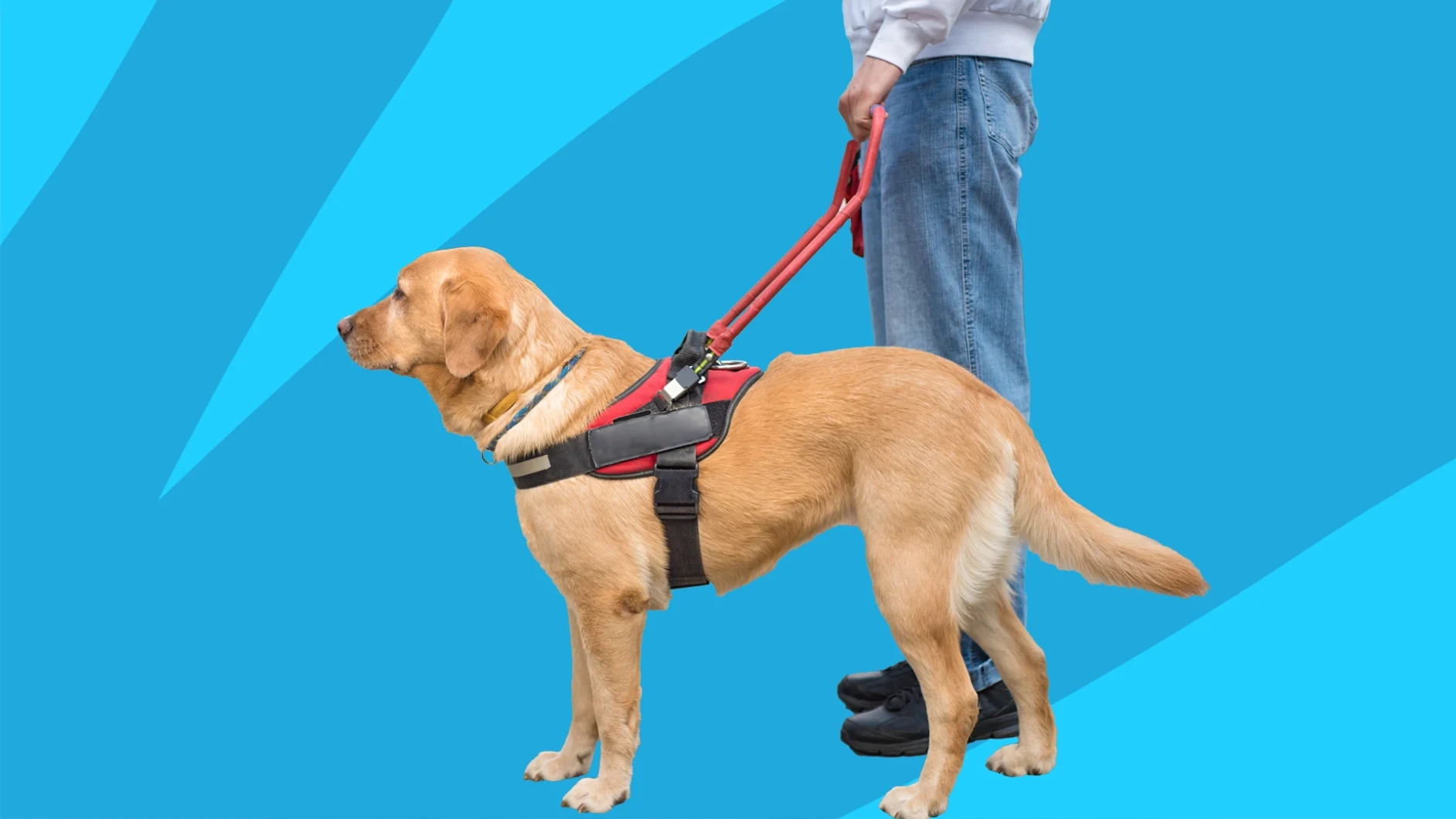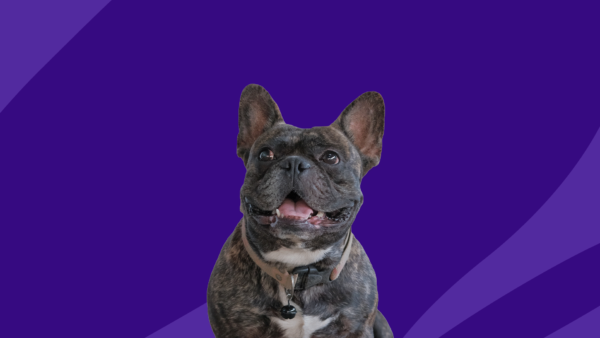Key takeaways
Service animals are dogs of any breed or size that are trained to perform a task directly related to a person’s disability, according to the Americans with Disabilities Act.
Service animals are not the same as emotional support or comfort dogs.
Only dogs are officially recognized as service animals under titles II and III of the ADA. However, the ADA has certain provisions for miniature horses acting as service animals.
A service animal’s tasks must directly relate to the person’s disability, which may be related to physical, sensory, psychiatric, intellectual, or mental health.
To be eligible for a service animal, you must meet the ADA criteria for a disability and have documentation from a medical professional that indicates a service dog could improve or support your condition.
Have you ever noticed those well-behaved dogs walking through the grocery store or perhaps an airport, wearing a red vest and heeling perfectly alongside their owner? The chances are the dogs you’ve seen are service animals.
There are an estimated 500,000 service dogs in the United States. And although dogs are more common, miniature horses can also be service animals. This article will focus on how dogs function as service animals, including the health benefits they provide to their owners and how you may qualify for one.
What is a service animal?
According to The Americans with Disabilities Act, service animals are dogs:
- Of any breed or size
- Trained to perform a task directly related to a person’s disability
However, depending on who you ask, it is common to hear different answers regarding certification requirements. Service animals don’t need a certification, nor do they need to undergo professional training. They aren’t obligated to wear a vest or any form of identification signifying their service dog status.
Plus, service animals differ from emotional support or comfort dogs, as their role doesn’t center on providing emotional support or comfort related explicitly to a person’s disability.
The importance and roles of service animals
A service animal is a trained dog that helps someone with a disability by performing specific tasks. Disabilities can be physical, sensory, psychiatric, intellectual, or mental health-related.
A service animal’s tasks must directly relate to the person’s disability. Examples include:
- Guiding individuals who are blind or have low vision
- Alerting people who are deaf or hard of hearing to sounds or people
- Offering protection or rescue work without violence
- Pulling a wheelchair
- Assisting during a seizure
- Notifying about allergens
- Retrieving items like medicine or the telephone
- Providing physical support and helping with balance for those with mobility issues
- Assisting individuals with psychiatric or neurological disabilities by preventing impulsive or destructive behaviors
Simply stated, service animals are trained to help people with disabilities lead a life that offers them more independence than they would have on their own.
How to qualify for a service animal
Whereas some establishments claim to provide service animals, it is important to go through the proper channels to ensure the animal you receive has received proper training overseen by experts.
Numerous organizations and individuals specialize in training service dogs in the United States. Their goal is to teach dogs specific skills tailored to a handler’s disability. They must also train service dogs in behaviors like house training, calmly settling beside the handler in public, and maintaining control in various environments.
Adhering to rigorous standards, professional service dog trainers face dropout rates ranging from 50% to 70% for potential service dogs. Fortunately, there are typically many homes willing to welcome dogs that don’t meet the necessary criteria.
To be eligible for a service dog, individuals must meet the ADA criteria for a mental or physical disability. However, simply having a qualifying disability typically isn’t sufficient; the person also needs documentation from a medical professional that indicates that the service animal could improve or support his or her condition.
Initiating this process often involves contacting a medical professional (such as your primary care provider). Be aware that service animals aren’t a one-size-fits-all solution: Assessing your needs and determining how a service animal could assist you will be a big part of the decision-making process. Additionally, it’s important to note that acquiring and maintaining a trained service animal can be a significant investment due to associated costs like food and veterinary bills.
Federal regulations on service animals
A service animal should remain under the handler’s control in accordance with ADA guidelines. Typically, service animals must be harnessed, leashed, or tethered. Exceptions exist if the individual’s disability hinders the use of such devices or if these devices would interfere with the service animal’s safe and effective performance of necessary tasks. Maintaining control through voice, signals, or other effective means is necessary in these cases.
Under ADA regulations, state and local governments, businesses, and public-serving nonprofit organizations are generally obligated to permit service animals to accompany individuals with disabilities in all public areas of their facilities. For instance, excluding a service animal from areas such as patient rooms, cafeterias, clinics, and examination rooms in hospitals is inappropriate. However, sterile environments, such as operating rooms and burn units, may warrant the exclusion of service animals to maintain aseptic conditions.
Furthermore, a state or local government entity or business may request the removal of a service animal under the following circumstances:
- The dog is not properly housebroken
- The dog is unruly, and the individual is unable to regain control of the dog
State or local authorities have the authority to:
- Mandate licensing and vaccination for service dogs if such requirements apply to all dogs
- Implement voluntary service dog registration initiatives
However, state or local governments are prohibited from:
- Imposing mandatory certification or registration for service dogs
- Prohibiting service dogs based on their breed
The ADA’s definition of disability
According to the ADA, an individual with a disability is someone with a physical or mental impairment that significantly impairs his or her ability to conduct one or more major lifestyle activities. This definition extends to those with a documented history of such an impairment, even if they are not presently experiencing a disability.
Additionally, it includes individuals who may not have a disability but are perceived as having one. The ADA prohibits discrimination against individuals based on their association with someone with a disability.
Types of disabilities
Service animals can support a broad range of physical and sensory as well as psychiatric, intellectual, and other mental disabilities. Physical disabilities that might make a person eligible for a service dog include:
- ALS
- Arthritis
- Cancer
- Cerebral palsy
- Chronic pain
- Diabetes
- Multiple sclerosis (MS)
- Muscular dystrophy
- Parkinson’s disease
- Paralysis
- Sensory disabilities (blind, deaf, etc.)
- Spinal cord injury
- Stroke
- Vertigo
The types of disorders classified as mental disabilities in the Diagnostic and Statistical Manual of Mental Disorders include:
- Addiction, substance abuse, and alcoholism
- Anxiety disorders and phobias
- Autism
- Bipolar disorders
- Depression and depressive disorders
- Dissociative and personality disorders
- Neurocognitive and sleep-wave disorders
- Obsessive-compulsive disorders
- Attention deficit hyperactivity disorder (ADHD)
- PTSD, trauma, and stress-related disorders
- Schizophrenia and psychotic disorders
Note that the manual is particularly relevant for those with psychiatric service animals, emotional support animals, or therapy animals, as individuals with service dogs are not obligated to provide documentation or proof of their disability.
Determining the need for a service animal
If you feel you qualify for a service animal, the next consideration is whether you need one or could potentially benefit from one.
Here are some questions to ask yourself to determine your individual need:
- Do you have any form of mental or emotional illness?
- Have you ever had or do you currently have suicidal thoughts?
- Do you have any physical disabilities?
- Do you suffer from a sensory disability?
- Do you suffer from muscular dystrophy?
- Do you have learning disabilities?
- Do you suffer from anxiety, depression, or any type of phobia?
- Do you have a cardiac disability or ailment?
- Do you need regular assistance with day-to-day tasks due to illness?
Checking this assessment with your healthcare provider will help determine if you need a service animal.
Importance of a health professional’s assessment
Involving healthcare professionals in deciding to have a service animal is a must. Medical professionals recognize the inherent understanding dogs have of their owners’ distress, offering comfort by just being present.
However, when a dog is trained to address specific physical, emotional, or mental conditions, it becomes a valuable part of the person’s treatment plan. Although a doctor’s note isn’t mandatory for gaining a service dog, seeking a healthcare perspective will ensure proper care for your condition. It will also help you consider various treatment options alongside a service animal.
How service animals can help
Service animals play vital roles in assisting individuals with disabilities. Take Madison and her diabetic-alert dog, Willy. Since January 2017, Willy (a golden retriever) has been Madison’s constant companion. His keen senses detect drops in Madison’s blood sugar before her monitor does. He signals by pawing or lying at her feet, prompting her to consume juice or applesauce. In critical situations, Willy fetches glucose tablets, brings Madison her phone to call 911, and alerts neighbors for help.
In another inspiring story, Salty and Roselle, Labrador guide dogs, demonstrated extraordinary loyalty during the 9/11 World Trade Center attack. These brave canines guided their blind owners safely down more than 70 floors through debris, ultimately saving their lives. Their heroism earned them the prestigious Dickin Medal and several other honors, including ‘Partners in Courage’ and ‘Hero Dog of the Year.’
How to acquire a service animal
Receiving a healthcare provider’s recommendation that a service animal may help isn’t challenging; however, the process of acquiring a service animal takes some work. Unfortunately, there are often not enough service animals to go around. This is because it can take about two years to train a service dog. The process starts when the dogs are puppies and continues until their training is complete when they have matured. However, if you and your healthcare professional believe you could benefit, there are some specific steps you should take.
- Research organizations specializing in training dogs for your specific condition.
- Consider your needs and preferences when selecting a suitable breed for your service animal.
- Evaluate each organization’s training program to ensure it aligns with your requirements. For instance, you want to avoid punishment-based approaches.
- Collaborate with the organization’s staff and volunteers to assess the compatibility of a service dog with your lifestyle.
- Recognize that acquiring a service dog may take several months and may involve intensive team training and bonding sessions. Explore professional training options, like “Board and Train,” for quicker access.
- Choose an organization with a screening process for health and temperament to ensure you receive a service dog who is well-suited to you.
Finding a suitable animal
Selecting a service dog involves considering various factors. Although any dog breed can be a service dog, suitability varies based on individual needs, personalities, and living situations. Begin by identifying the tasks you need assistance with and how your disability impacts daily life.
Consult with your healthcare provider, family, and other service dog users for insights. What kind of assistance you need will influence size: larger breeds offer stability, whereas smaller ones are more cost-effective. Assess your personality to ensure compatibility with a type of breed, such as a hound, retriever, guard dog, or toy breed.
What kind of animals qualify?
Since March 15, 2011, only dogs are officially recognized as service animals under titles II and III of the ADA. While the definition of a service animal by the ADA is limited to dogs, the ADA does have specific provisions for miniature horses acting in a service animal role. These state that entities covered by the ADA must permit miniature horses where reasonable. To qualify, both dogs and miniature horses must be specifically trained to perform tasks or work for an individual with a disability. This distinction ensures that service animals are well-trained and capable of assisting those in need.
What kind of animals do not qualify?
According to the ADA, only dogs and miniature horses trained to perform tasks or work for an individual with a disability qualify. This means all other animals are ineligible for this designation. The focus on dogs ensures consistency in training and reliability.
However, it’s important to note that emotional support animals (ESAs) serve a different role. ESAs can be any domesticated animal, such as cats, dogs, mice, rabbits, birds, hedgehogs, rats, minipigs, and ferrets, that provide emotional support to individuals with disabilities but do not possess the specialized training required of service animals.
The best breeds for service tasks
The best service dogs are intelligent and have a reliable temperament. For this reason, the most common breeds for service tasks tend to be Labrador retrievers, German shepherds, and golden retrievers. Also popular are poodles, Bernese mountain dogs, collies, Great Danes, Pomeranians, and American Staffordshire terriers. The best dogs are able to stay focused, remain attentive, and are unphased by crowds, traffic, loud noises, or other animals.
Training requirements
As mentioned earlier, the ADA does not require service animals to be certified or undergo a professional training program.
Here are the traits that the ideal service dog should possess:
- Calmness
- Alertness without reactivity
- A desire to please
- Learning capabilities
- Adaptability to diverse situations
- Reliability in task performance
Legal rights of service animal owners
As a service animal owner, you have certain legal rights that protect you related to housing, travel, and education. Laws are in place to ensure that you can participate in daily activities, free from scorn related to the presence of your service animal.
Public access laws and regulations
The ADA’s Titles II and III ensure service animals’ rights in public spaces, overriding “no pets” policies. Businesses cannot exclude service animals. Only two questions about the animal’s purpose and training are permitted when entering public places:
- Is the animal required because of a disability?
- What work or task has the animal been trained to perform?
However, these shouldn’t be asked if the service tasks are evident.
Businesses can’t demand documentation or charge extra fees for service animals; breed-specific laws and pet-related charges do not apply to service animals. The ADA protects individuals with disabilities, ensuring equal access to public facilities without unnecessary inquiries or financial burdens.
Housing laws pertaining to service animals
The Fair Housing Act (FHA) safeguards people with disabilities, ensuring equal housing opportunities. Landlords must make reasonable accommodations, such as waiving pet rules for service animals and qualifying emotional support animals.
The FHA prohibits inquiries into the nature of a disability but may request documentation to evaluate a particular accommodation. Certifying in writing the disability, the need for the animal, and its assistance is acceptable. It’s important to understand that the ADA rules may also apply to housing, such as student housing, where documentation requirements are restricted for animals deemed service animals.
Travel laws for service animals
Travel laws ensure those with service animals can’t be denied transportation, charged extra fees, or forced into specific seats. These laws apply to public and private transport, including subways, buses, and airlines.
The Air Carrier Access Act specifies service animals as trained dogs, excluding other species, emotional support animals, and animals in training. Airlines must recognize dogs as service animals for U.S. flights but can deny transport if safety, health, or disruption concerns arise.
Although forms are optional, airlines may choose only to allow transport with completed DOT service animal forms.
Service animals vs. emotional support animals
It is not uncommon for people to confuse service animals with emotional support animals. There are some key differences.
Distinctions between emotional support and service animals
Not every animal meets the ADA’s definition of a service animal. The U.S. Department of Housing and Urban Development (HUD) defines emotional support animals as those that ease disability symptoms. They offer companionship, ease loneliness, and aid with emotional issues but lack specific training for disability assistance tasks.
Comfort and therapy animals (usually dogs) are helpful in high-stress situations. Comfort animals aid during active crises, providing calming distractions. Therapy animals offer healing contact in institutional or clinical settings.
The different regulations for service and emotional support animals
People with disabilities use working animals for various reasons. However, only specially trained dogs that perform specific tasks qualify as service animals. For this reason, the regulations that apply to service animals do not apply to emotional support animals. This means businesses and your local government can choose whether to offer accommodations to emotional support animals, taking the safety of others into consideration.
FAQs
What types of disabilities qualify you for a service animal?
Service animals can support a wide range of disabilities, including physical, sensory, psychiatric, intellectual, and mental disabilities. Examples include cerebral palsy, multiple sclerosis (MS), autism, PTSD, trauma and stress-related disorders, and schizophrenia and psychotic disorders.
What are the key differences between service animals and emotional support animals?
Service animals are specifically trained to assist their owners with various lifestyle-related tasks, whereas emotional support animals provide comfort, ease loneliness, or assist in aiding emotional issues.
What breeds make the best service animals? Are there specific animals that do not qualify?
Only dogs qualify as service animals, as per the ADA. The most common breeds are German shepherds, Labrador retrievers, and golden retrievers. No other animals qualify as service animals, though other types of animals may qualify as emotional support animals.
Sources
- Animal therapy statistics, The Zebra (2023)
- Service animals, U.S. Department of Justice Civil Rights Division (2023)
- Service animals, Americans with Disabilities Act National Network (2017)
- Service dog 101: everything you need to know, American Kennel Club (2023)
- What disabilities qualify for a service dog?, U.S. Service Animals (2019)
- ADA requirements: service animals, U.S. Department of Justice Civil Rights Division (2020)
- What is the definition of disability under the ADA?, Americans with Disabilities Act National Network (2023)
- Disabilities that qualify you for a service dog, Service Dog Certifications (2023)
- Diagnostic and Statistical Manual of Mental Disorders (DSM-5-TR), American Psychiatric Association (2023)
- Do I need a service dog quiz, ProProfs Quizzes (2022)
- These stories show just how important service animals can be, The Hour (2019)
- Appollo, Roselle and Salty, People’s Dispensary for Sick Animals (2022)
- How to acquire a service dog, Educated Canines Assisting with Disabilities (2023)
- Emotional support animals: the basics, UMass Chan Medical School (2023)
- Most popular service dog breeds, American Kennel Club (2021)
- Service animals and emotional support animals; where are they allowed and under what conditions?, Americans with Disabilities Act National Network (2014)
- Service Animals, U.S. Department of Transportation (2021)











